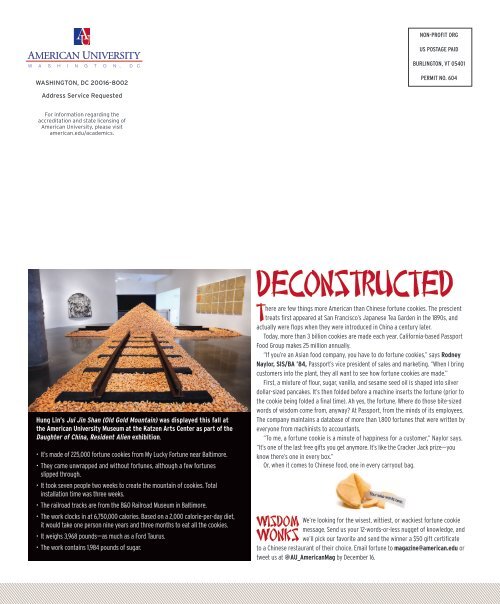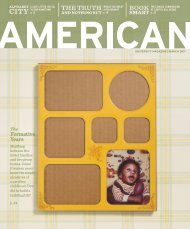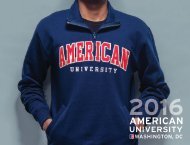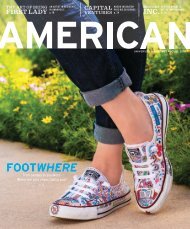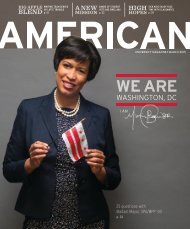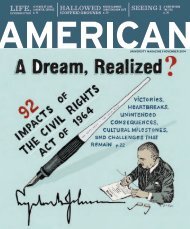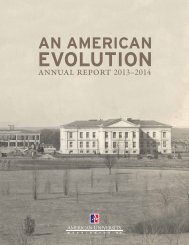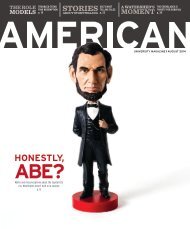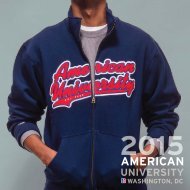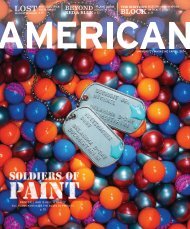American Magazine: November 2016
In this issue, delve into the Scandal-ous life of Judy Smith, meet ESPN’s new public editor, reflect on a decade of transformation under President Neil Kerwin, and learn more about autism—the fastest growing developmental disorder in the United States. Hop on the Metro to Capitol South and get to know a few of AU’s 1,068 Seattle transplants.
In this issue, delve into the Scandal-ous life of Judy Smith, meet ESPN’s new public editor, reflect on a decade of transformation under President Neil Kerwin, and learn more about autism—the fastest growing developmental disorder in the United States. Hop on the Metro to Capitol South and get to know a few of AU’s 1,068 Seattle transplants.
You also want an ePaper? Increase the reach of your titles
YUMPU automatically turns print PDFs into web optimized ePapers that Google loves.
NON-PROFIT ORG<br />
US POSTAGE PAID<br />
BURLINGTON, VT 05401<br />
WASHINGTON, DC 20016-8002<br />
PERMIT NO. 604<br />
Address Service Requested<br />
For information regarding the<br />
accreditation and state licensing of<br />
<strong>American</strong> University, please visit<br />
american.edu/academics.<br />
Hung Lin’s Jui Jin Shan (Old Gold Mountain) was displayed this fall at<br />
the <strong>American</strong> University Museum at the Katzen Arts Center as part of the<br />
Daughter of China, Resident Alien exhibition.<br />
• It’s made of 225,000 fortune cookies from My Lucky Fortune near Baltimore.<br />
• They came unwrapped and without fortunes, although a few fortunes<br />
slipped through.<br />
• It took seven people two weeks to create the mountain of cookies. Total<br />
installation time was three weeks.<br />
• The railroad tracks are from the B&O Railroad Museum in Baltimore.<br />
• The work clocks in at 6,750,000 calories. Based on a 2,000 calorie-per-day diet,<br />
it would take one person nine years and three months to eat all the cookies.<br />
• It weighs 3,968 pounds—as much as a Ford Taurus.<br />
• The work contains 1,984 pounds of sugar.<br />
DEconstructed<br />
There are few things more <strong>American</strong> than Chinese fortune cookies. The prescient<br />
treats first appeared at San Francisco’s Japanese Tea Garden in the 1890s, and<br />
actually were flops when they were introduced in China a century later.<br />
Today, more than 3 billion cookies are made each year. California-based Passport<br />
Food Group makes 25 million annually.<br />
“If you’re an Asian food company, you have to do fortune cookies,” says Rodney<br />
Naylor, SIS/BA ’84, Passport’s vice president of sales and marketing. “When I bring<br />
customers into the plant, they all want to see how fortune cookies are made.”<br />
First, a mixture of flour, sugar, vanilla, and sesame seed oil is shaped into silver<br />
dollar-sized pancakes. It’s then folded before a machine inserts the fortune (prior to<br />
the cookie being folded a final time). Ah yes, the fortune. Where do those bite-sized<br />
words of wisdom come from, anyway? At Passport, from the minds of its employees.<br />
The company maintains a database of more than 1,800 fortunes that were written by<br />
everyone from machinists to accountants.<br />
“To me, a fortune cookie is a minute of happiness for a customer,” Naylor says.<br />
“It’s one of the last free gifts you get anymore. It’s like the Cracker Jack prize—you<br />
know there’s one in every box.”<br />
Or, when it comes to Chinese food, one in every carryout bag.<br />
We’re looking for the wisest, wittiest, or wackiest fortune cookie<br />
message. Send us your 12-words-or-less nugget of knowledge, and<br />
we’ll pick our favorite and send the winner a $50 gift certificate<br />
to a Chinese restaurant of their choice. Email fortune to magazine@american.edu or<br />
tweet us at @AU_<strong>American</strong>Mag by December 16.


